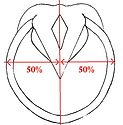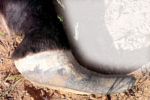Advertise Follow Us
Articles Tagged with ''Hoof Balance''
Common Hoof Beliefs — Uncommon Measurements
Digital imaging and measuring software present a challenge to six farriery adages
Read More
Product Innovations
Will These Products Find a Place in Your Toolbox?
Farrier inventors hope their ideas will pay off
Read More
Shoeing For A Living
To The Last Full Measure
Wisconsin farrier’s shoeing style all comes down to the numbers
Read More
Making Sense Of Hoof Balance
Several theories and models are available, but knowing which principles to choose and when to use them can make the difference between soundness and lameness
Read More
How To
Hoof Growth And Stimulation
Proper balance plays a key role in developing strong, healthy hooves
Read More
Farrier Science And Economic Loss Due To Lameness
Study finds important differences regarding perceptions of farrier skills and abilities
Read More
Bringing Horses Back In Balance
Medial and lateral balance is the first step, but don't forget to look for anterior and posterior balance
Read More
New Technique For Quantitative Measurement Of Hoof Balance
This study used digital image analysis to evaluate 46 measures of static hoof balance
Read More










